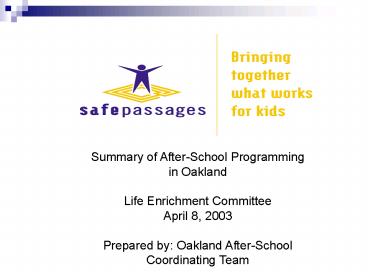SAFE PASSAGES Oakland, California - PowerPoint PPT Presentation
1 / 16
Title: SAFE PASSAGES Oakland, California
1
Summary of After-School Programming in
Oakland Life Enrichment Committee April 8,
2003 Prepared by Oakland After-School
Coordinating Team
2
Overview of Presentation
- History of after-school in Oakland
- Summary of current data on capacity and cost
- Pending changes to the after-school landscape
- Scenarios for consideration
3
History of Oaklands Investment in After-School
- 1985-1989 two staff on all elementary
playgrounds (one male and one female) - 1990s budget reductions resulted in a decrease
in programming - 1993 OPR operated 13 after-school program sites
at elementary schools not served by nearby
recreation centers - 1997 OFCY begins funding after-school programs
provided by community based organizations - 2003- OPR elementary sports serves 15 elementary
schools, OPR Middle School sports serves 14
middle schools
4
Oakland Parks and Recreation Budget and
Expenditure Information
- OPRs 2002-2003 budget is 27,675,956
- In FY 2002-2003, the approved budget included
395.78 FTE - In 2002-2003 10 Full-Time Recreation Program
Directors were budgeted - OPR has hired part-time staff positions during
the peak summer season. These have been linked to
vacant full-time budgeted positions in the
department owing to the need for both fiscal
flexibility and budgetary solvency by OPR
components.
5
Defining After-School
- There are 3 primary types of after-school
programming - Academic
- Enrichment
- Recreation
- A comprehensive after-school program
- Has all three at one site (does not need to be
one provider) - And is accessible 2-3 hours a day Monday-Friday
6
Current Challenges with Data Collection
- Each public system collects data in different
ways - There is no system to collect non public system
data - The definitions of after-school are not universal
- There is a rapidly changing landscape for
programming - Numbers do not capture quality of programming
7
Summary of Current Capacity and Equity
- Between 60 and 65 of Oakland children need
after-school programming - Citywide, we currently serve approximately 30 of
elementary and middle school students through
public systems - We serve approximately 20 of the high school
population
8
Current Landscape of Funding
- The two largest sources of funding for
after-school are OFCY and state and federal
grants through the school district - The after-school coordinating team is working to
coordinate funding resources to ensure that
funding is more evenly distributed based on need
9
What happens to funding in 2003-2004?
- Next year Oakland will lose almost 4 million
dollars in state and federal grants - This will affect almost 4,000 youth, more than
half of which are elementary students - This will result in the following drops in
service - Elementary students, 30 to 23
- Middle school students, 30 to 21
- High school student, 18 to 14
10
Possible Scenarios
- Use of college students to staff school sites
- Expansion of Passport Programs
- OPR staff at school sites
- Comprehensive CBO model
11
College Students to Staff School Sites
- Students could be compensated through school
credit instead of payment - Strong administrative structure and training
would be needed - OUSD would need to approve the collaboration and
provide access to facilities
12
Expand Passport Program
- Focuses on using already existing resources
- Provides services 3 hours a day, 5 days a week,
for 37 weeks - Uses 1 dedicated part-time recreation leader and
specialists - Provides service to 20-25 youth per site
- Costs approximately 13,500 per site
13
Provide OPR staff at school sites
- Provides services 3 hours a day, 5 days a week,
for 37 weeks - Uses 2 dedicated permanent part-time recreation
leaders - Provides service to 40-60 youth per site
- Costs approximately 51,000 per site
14
Provide Comprehensive CBO model
- Provides services 3 hours a day, 5 days a week,
for 37 weeks - Provides service to 50 youth per site
- Components offered by specialized staff
- Costs approximately 75,000 per site
15
Target Population Options
- Grade Level
- Income
- Geography
16
Next Steps
- Define agreed upon standards to ensure that all
programs encourage the best possible outcomes for
youth. - Coordinate current programs to provide more
consistent opportunities at each site. - Increase funding for after-school programs to
make up for a severe loss in funding next year. - Create policies to 1) get more consistent data
from public systems, 2) analyze it, 3) use it for
funding decisions, and 4) provide technical
assistance.































